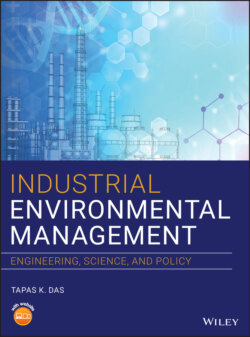Читать книгу Industrial Environmental Management - Tapas K. Das - Страница 56
References
Оглавление1 Allen, D.T. and Behmanish, N. (1994). Wastes as raw materials. In: The Greening of Ecosystems (eds. B. Allenby and D. Richards). Washington, DC: National Academy Press.
2 Allen, D.T. and Rosselot, K.S. (1997). Pollution Prevention for Chemical Processes, 19–32. New York, NY, Chapter 2: Wiley.
3 Allen, D.T. and Shonnard, D.R. (2012). Sustainable Engineering: Concepts, Design, and Case Studies. Upper Saddle River, NJ: Prentice Hall.
4 Allenby, B.R. and Richards, D.J. (1994). The Greening of Industrial Ecosystems. Washington, DC: National Academy Press.
5 Ayres, R.U., Ayres, L.W., and Ayres, L. (1996). Industrial Ecology: Towards Closing the Materials Cycle. Cheltenham, UK: Edward Elgar.
6 Cote, R.P. (1995). Supporting pillars for industrial ecosystems. Journal of Cleaner Production 5 (1–2): 67–74.
7 Cote, R.P. (2003). A Primer on Industrial Ecosystems: A Strategy for Sustainable Industrial Development, 1–34. Halifax, NS: Eco‐Efficiency Center, School for Resources and Environmental Studies, Dalhousie University.
8 Das, T.K. (2005). Toward Zero Discharge: Innovative Methodology and Technologies for Process Pollution Prevention. Hoboken, NJ: Wiley.
9 Delmas, M. (2009). Erratum to “Stakeholders and Competitive Advantage: The Case of ISO 14001”. Production and Operations Management. 13 (4): 398.
10 Graedel, T.E. and Allenby, B.R. (1995). Industrial Ecology. Englewood Cliffs, NJ: Prentice Hall.
11 Grann, H. (1994). The industrial Symbiosis at Kalundborg, Denmark. Paper presented at the National Academy of Engineering's Conference on Industrial Ecology, Irvine, CA (9–13 May 1994).
12 Herman, R. (1989). Technology and Environment. Washington, DC: National Academy Press.
13 Hutchens, S. (2010). Using ISO 9001 or ISO 14001 to gain a competitive advantages. Intertake. www.intertek‐sc.com (accessed 21 September 2019).
14 Johnson, J., Harper, E.M., Lifset, R., and Graedel, T.E. (2007). Dining at the periodic table: metals concentrations as they relate to recycling. Environmental Science and Technology 41: 1759–1765.
15 Pauli, G. (1996). Breakthroughs. Haslemere, Surrey: Epsilon Press.
16 Potoski, M. and Prakash, A. (2005). Green clubs and voluntary governance: ISO 14001 and firms' regulatory compliance. American Journal of Political Science 49 (2): 235.
17 Sheldon, C. (1997). ISO 14001 and Beyond: Environmental Management Systems in the Real World. New York: Prentice Hall.
18 USEPA (1992). Facility Pollution Prevention Guide, EPA/600/R‐92/088. Washington, DC: USEPA, Office of Research and Development.
19 Van der Veldt, D. (1997). Case studies of ISO 14001: a new business guide for global environmental protection. Environmental Quality Management 7 (1): 1–19.
20 World Commission on Environment and Development (1987). Our Common Future. Oxford University Press, Oxford, UK.
21 Zacerkowny, O. (2002). Not a drop leaves the plant. Pollution Engineering 34: 19–22.
